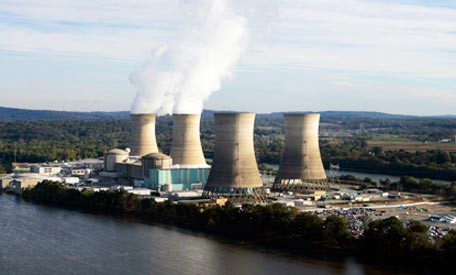On March 28, 1979, the Three Mile Island nuclear power plant experienced a partial meltdown. It was the worst-ever commercial nuclear accident in American history.
Meltdown in Pennsylvania
The Unit Two reactor at the Three Mile Island nuclear facility near near Middletown, Pa., had an unstable operating history. Even during construction there were delays, and unscheduled shutdowns persisted after the reactor began operating in 1978. Operators compensated for these deficiencies by falsifying data to avoid reporting to the Nuclear Regulatory Commission (NRC).
At about 4:00 a.m. on March 28, 1979, a pump failure in a secondary (non-nuclear) system of the reactor stopped steam generators from removing heat from the unit, increasing the pressure in the primary (nuclear) portion.
A relief valve was opened to release the pressure, but the valve stuck and didn’t close. There were no warning alarms indicating that something was wrong with the valve. As a result, vital cooling water was released while the reactor began to overheat. Other warnings lights and alarms signaled that the reactor was not running correctly, but operators were getting confusing messages and they had experienced false alarms before.
It was hours before they acknowledged that there was a problem, and even longer before they alerted the public. In the hours that followed, radiation was released from the plant, sparking concern from public officials that residents near the plant might have to be evacuated.
The full damage to the reactor remained unknown until years later when television cameras and a special ultrasonic imaging system provided the first pictures from inside the structure. Cleanup of the accident required $1 billion and more than 10 years to complete, according to The Washington Post. Officials believed the plant would be repaired and put back into service, but some features of the reactor couldn’t be repaired because they had melted.
Investigations into the Accident
The Kemeny and NRC reports are available from Dickinson College, which has a collection of reports on the accident.
Following the accident, President Carter commissioned an investigation headed by Dartmouth College president John Kemeny. The President’s Commission on the Accident at Three Mile Island released its report in October 1979. It was highly critical of the plant’s management and the Nuclear Regulatory Commission.
It concluded, “It is further concluded that the management utility joined the narrow and confined view on the safety items and virtually ignored other vital parts of plant operation…This illustrated that the utility management had not exhibited the desire or capacity to go beyond the NRC requirements to provide a well-designed, maintained, and staffed plant capable of reliable performance that would not jeopardize the health and safety of the public and its own workers.”
The NRC also conducted an investigation and released a report in 1980. It found that the plant equipment was generally sound, and placed blame for the accident primarily on human error.
“If this system had been allowed to function automatically, as intended, it would have mitigated the effects of the loss-of coolant and cooled the core,” it stated. “The operators’ actions, which led to the severe core damage that characterized the TMI accident, resulted from their failure to understand basic plant conditions that were indicated to them, or to follow appropriate procedures or prudent operating practices, any one of which could have prevented the severe core damage. This demonstrated a deep and significant weakness of the operating crew on shift.”
The NRC also released a fact sheet in 2004 that summarized its findings. Three Mile Island Alert, a central Pennsylvania-based citizens watchdog group founded in 1977, offers a point-by-point criticism of the NRC report.
Sources in this Story
- Smithsonian National Museum of American History: Three Mile Island: The Inside Story
- The Washington Post: Continuing Cleanup: $1 Bil. and Counting
- The New York Times: Study of Three Mile Island Accident Finds Negligible Increase In Cancer
- PBS: Meltdown at Three Mile Island
Radiation Release and Health Risks
Studies by the Nuclear Regulatory Commission, the Environmental Protection Agency, the Department of Health and Human Services, the Department of Energy and the State of Pennsylvania found that the radiation released from the plant was not significant enough to threaten human health.
Despite the results of studies that called the radiation release negligible, some disagreed with the findings. Rates of certain cancers did increase after the accident, but researchers did not consider the increase statistically significant, The New York Times wrote in 1990. Three Mile Island Alert, a nonprofit citizens’ organization, said research didn’t consider the physical and psychological effects felt by residents living close to the reactor.
Reference: Documents and News Stories
Dickinson College features a large collection of documents and multimedia content related to Three Mile Island, including government reports, newspaper stories and witness interviews.
The Washington Post released a 14-chapter special report shortly after the accident.
In 2012, we published this article about this historic event on the New York Times Learning Network. This article connected the event to current issues and offered reflection questions to help the reader think about its relevance today.











